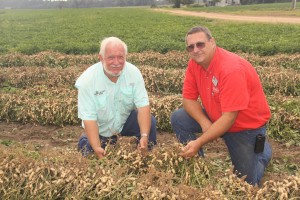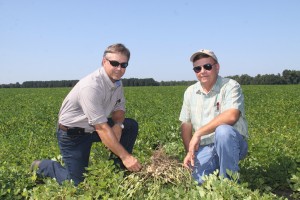Attendees also learned about peanut diseases from Dr. Tim Brenneman, University of Georgia research and Extension plant pathologist. His main research on peanuts revolves around soil borne diseases including white mold, Rhizoctonia, Cylindrocladium black rot. He also works on nematodes and nematode management. He works on a very active program developing fungicides and overall management programs for farmers. According to Brenneman, the 2014, crop has not been severe for disease issues so far. Early on we had a few issues with seedling disease, Aspergillus Crown rot and getting good stands established. That was early in the year so most farmers were able to get a reasonable stand. “Recently, we have had a lot of underground white mold and I think we are in the initial stages on seeing how that will develop,” Brenneman says. “I think there is a lot we will learn as peanuts are being dug.”
Author: joycrosby
Calcium – important nutrient for peanuts
While at the Southeast Georgia Research and Education Center, Glen Harris University of Georgia Extension soils and fertilizer specialist visited with attendees about calcium nutrition for peanuts. For the last three or four years we’ve really focused on calcium nutrition on peanuts, Harris says. The focus started when the industry shifted from small seeded to large seeded peanut varieties. Harris has been comparing the varieties and the calcium requirements needed. According to Harris, he found out that growers can maintain using the University of Georgia old recommendations on the new larger seeded peanut varieties.
Since then, Harris’ research has shifted more into looking at ways of providing calcium to the pegging zone of peanuts which is really important for the yields. He is also looking at different gypsums, calcium chloride and lime through the pivot. Although, the old standard Extension recommendation is if you need calcium then apply 1,000 pounds of gypsum at bloom time is still the standard today for growers.
The 2014 peanut crop of irrigated peanuts look good but the dryland peanuts have suffered a little. As far as nutrients, Harris says, he hasn’t noticed any major nutrient problems. However, he is a little concerned with the calcium nutrition in dryland because you need the water to get the calcium into the nut so you don’t get pops. “So, we might find that we have a little lower yields and pops, due not only to the drought, but maybe even due to some calcium issues,” Harris says. He says there’s not a whole lot growers can do about that, if you do everything you can and still get dry weather. But overall, the 2014 crop, nutritionally, is looking very good, he adds.
Peanut pests in 2014
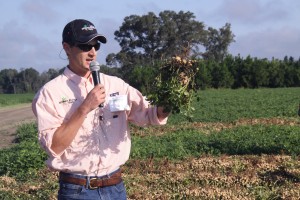 Mark Abney, peanut entomologist at UGA, visited with Georgia Peanut Tour attendees during the three-day tour on the various pest issues and the research he has been working on the last two years.
Mark Abney, peanut entomologist at UGA, visited with Georgia Peanut Tour attendees during the three-day tour on the various pest issues and the research he has been working on the last two years.
“Some of the things that are really exciting to me in terms of entomology research are the economic thresholds we are developing for a lot of the pests we have in peanuts,” Abney says. “That’s very important to growers so they know when to spray or not to spray so that we are not wasting money by not treating when we need to or by over treating when we don’t need to be spraying.”
Abney also has an efficacy testing program where he looks at all of the new chemistries and some of the older chemistries on the established pests we have to determine what is the best product to use for the pests we have in peanuts.
According to Abney, 2014 has been a very buggy year. He says the year started out early with thrips, very much like in 2013. Then growers went straight from that to some caterpillar problems that have been higher than a normal year.
The two things that have been really problematic for growers this year have been lesser cornstalk borer and two spotted spider mite. “Those are probably the two most important pests we have had in Georgia. They are not a pest every year but when they are it can be really problematic,” Abney says.
“We have spent a lot of money and heartache trying to control those two pests.” Both pests are very difficult to control especially in non-irrigated fields with the hot and dry conditions we have seen in 2014, he adds.
Abney credits the Georgia Peanut Commission for the research funding he receives and says it is extremely important for what he does at UGA. Without the funding, it would have been very difficult if not impossible to get his research program started. “We wrote a grant last year and received some money from the Georgia Peanut Commission which we were able to use to leverage with USDA to receive a larger grant from USDA this year,” Abney says. “This allows us to work on some of the thresholds for the key pests we have and without the Georgia Peanut Commission support we would not be able to do the research.”
Abney also has a blog where he provides growers the latest information on peanut pest issues at http://blog.extension.uga.edu/peanutent.
Research focus on tillage, row patterns, seeding rate & replanting
During the visit at the Southeast Georgia Research and Education Center Scott Tubbs, University of Georgia cropping systems agronomist, explained his research focus and provided an update on the 2014 Georgia Peanut Crop. The primary focus of his research program is to look at different aspects of peanut agronomics such as tillage, cover crop effects prior to the peanut crop, row patterns, seeding rates, plant populations, different planting date affects such as replanting and many other agronomics that effect various aspects of disease, entomology and weed science.
“Some of the primary issues of the 2014 peanut crop are mainly related to moisture and rainfall,” Tubbs says. “On the non-irrigated peanut crop we ended up with a lot of dryland peanuts that have not fully developed and are behind on maturity.” The yield looks like it will be suppressed. There was poor flowering and poor pod set on that crop early on when the rainfall stopped and we ended up with very dry conditions for the months of July and August. So those conditions are starting to become rectified with recent rainfall. However, we are getting to the point in the season where it is going to be difficult to make up the time we have lost for getting a good pod set and good yields on the dryland crop.
Some of the research funding from the Georgia Peanut Commission and the National Peanut Board are projects where I have looked at seeding rates and various replant decisions for peanuts. The trials are included in multiple locations throughout the state and at the Southeast Research and Education Center in Midville, Georgia. In these trials Tubbs looks at how important is it to get an established plant stand on the first planting. “If you can’t get a good established plant stand on the initial planting the amount of money it costs to go back into a field is costly to a grower,” he says. The additional costs include the cost of more passes through the field, additional cost of more seed and then also determining when is the appropriate time to dig based on maturity. With two different planting dates growing in the same field at the same it is very difficult to determine the optimum maturity. Because some peanuts will be over mature while others are immature.
A lot of information from the UGA Peanut Team is available online at ugapeanuts.com.
Technology on the farm
Joe Boddiford of Screven County, Georgia, visited with attendees during the first tour stop Thursday morning, Sept. 18, 2014. Boddiford has been farming since 1974 and follows in the footsteps of his father and grandfather. Joe took time to introduce his brother and cousin to tour attendees. “We have all been involved in agriculture our whole lives and we love it,” he says. He also introduced his son, Knapp Boddiford, and told a story about how Knapp got his name. His name comes from Seamen Knapp who actually drafted a bill for the establishment of experimental research stations, which later was introduced to the 47th Congress, laying the foundation for a nationwide network of agricultural experiment stations.
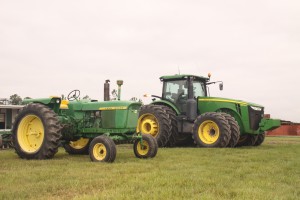 Use of technology on the farm was the main focus of this tour stop at Boddiford’s farm. Boddiford pointed to a 1962 John Deere 3010 tractor that Boddiford started farming with in 1974. His father originally purchased the tractor in 1962. Boddiford farmed with the 3010 for a number of years and needed a new tractor in the 1990s so he sold it but later regretted it. After many years, Boddiford saw a John Deere 3010 tractor at an auction in South Carolina, recognized it as the tractor he had sold earlier so he purchased it again from the auction for more money than he originally sold it for. Today, Boddiford has told his son that the 3010 tractor is one piece of equipment he can’t sell.
Use of technology on the farm was the main focus of this tour stop at Boddiford’s farm. Boddiford pointed to a 1962 John Deere 3010 tractor that Boddiford started farming with in 1974. His father originally purchased the tractor in 1962. Boddiford farmed with the 3010 for a number of years and needed a new tractor in the 1990s so he sold it but later regretted it. After many years, Boddiford saw a John Deere 3010 tractor at an auction in South Carolina, recognized it as the tractor he had sold earlier so he purchased it again from the auction for more money than he originally sold it for. Today, Boddiford has told his son that the 3010 tractor is one piece of equipment he can’t sell.
When comparing the 3010 tractor to other equipment sitting beside it tour attendees can quickly notice how times and technology has changed throughout the years. Boddiford first became involved with the latest technology when he attended a precision ag conference in 1996 and has since worked with the Extension service on several research projects using auto steer, yield monitoring and more. Boddiford also uses swath control on his sprayers which helps prevent spray overlap.
In addition to learning about Joe Boddiford’s farm, attendees were able to hear from researchers at Clemson University on the work they are doing with variable depth digging and peanut yield monitoring.
Click here to view their presentation.
The visit would not have been complete without an example of peanut digging in the field. Of course this two-row digger shown in the video has been retrofitted to look at variable depth digging in the research trial.
My oh My – Savannah, The Peanut Shop and Riverboat Cruise
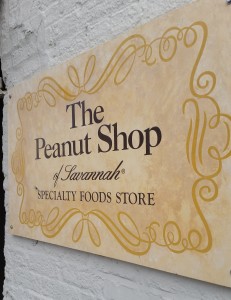 Each year the Georgia Peanut Tour Committee strives to showcase the southern hospitality of the state. One easy way to do that is location and food. This year had an array of both from visiting the first city in Georgia to a range of southern food including fried chicken, barbecue, ribs, peach cobbler, banana pudding and more. Savannah is known for it’s large oak trees towering over parks and roads throughout town. If those trees could talk they’d tell you about pirates, cotton, and a revolutionary town plan dating to 1733. They’d tell you about a citizenry that treats hospitality as an art form, of a St. Patrick’s Day celebration that defies description, and of a city’s beauty so profound that it stopped even General William Tecumseh Sherman in his tracks. Today, many things happening in the Savannah area are transforming the city into one of the most dynamic and creative economies in the southeast. Savannah has tons of history and jaw-dropping container ships traveling the waterfront of River St.
Each year the Georgia Peanut Tour Committee strives to showcase the southern hospitality of the state. One easy way to do that is location and food. This year had an array of both from visiting the first city in Georgia to a range of southern food including fried chicken, barbecue, ribs, peach cobbler, banana pudding and more. Savannah is known for it’s large oak trees towering over parks and roads throughout town. If those trees could talk they’d tell you about pirates, cotton, and a revolutionary town plan dating to 1733. They’d tell you about a citizenry that treats hospitality as an art form, of a St. Patrick’s Day celebration that defies description, and of a city’s beauty so profound that it stopped even General William Tecumseh Sherman in his tracks. Today, many things happening in the Savannah area are transforming the city into one of the most dynamic and creative economies in the southeast. Savannah has tons of history and jaw-dropping container ships traveling the waterfront of River St.
If you are ever in Savannah walking around River St. then you should stop by The Peanut Shop for samples of everything peanut. There is roasted peanuts, peanut brittle and peanut butter. However, the hundreds of cans of roasted peanuts are not your traditional salted peanuts. No, these cans are everything from Savory Dill Pickle, Bloody Mary, Sea salt and Cracked Pepper, Thai Fried Chili Lime, Spicy Mole, Salt and Vinegar, Spicy Smoky Redskin, Hot Habanero Chile Pepper, Bacon and Cheddar and more. The best part is free samples. If you are a peanut lover then be sure to visit The Peanut Shop the next time you are in Savannah.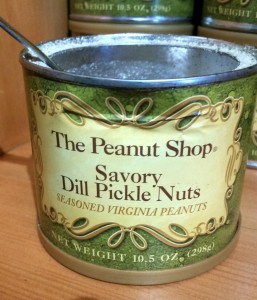
Following the tour of the Port of Savannah, tour attendees had a couple of hours to visit River Street before setting sail on the Savannah Riverboat Cruise. The two-hour cruise gave attendees an opportunity to see the city from a different view while enjoying good food and entertainment. If you are ever in the Savannah area then check out the riverboat cruise for a fun and relaxing time.
View the 2014 Georgia Peanut Photo Album.
Exports move in and out at the Port of Savannah
 The Port of Savannah is a major U. S. seaport located at Savannah, Georgia and also known as the Garden City Terminal. Its extensive facilities for oceangoing vessels line both sides of the Savannah River approximately 18 miles from the Atlantic Ocean. Operated by the Georgia Ports Authority (GPA), the Port of Savannah competes primarily with the Port of Charleston in Charleston, South Carolina to the northeast, and the Port of Jacksonville in Jacksonville, Florida to the south. The GPA operates one other Atlantic seaport in Georgia, the Port of Brunswick, located at Brunswick, Georgia, as well as two interior ports linked to the Gulf of Mexico, Port Bainbridge and Port Columbus.
The Port of Savannah is a major U. S. seaport located at Savannah, Georgia and also known as the Garden City Terminal. Its extensive facilities for oceangoing vessels line both sides of the Savannah River approximately 18 miles from the Atlantic Ocean. Operated by the Georgia Ports Authority (GPA), the Port of Savannah competes primarily with the Port of Charleston in Charleston, South Carolina to the northeast, and the Port of Jacksonville in Jacksonville, Florida to the south. The GPA operates one other Atlantic seaport in Georgia, the Port of Brunswick, located at Brunswick, Georgia, as well as two interior ports linked to the Gulf of Mexico, Port Bainbridge and Port Columbus.
Owned and operated by the Georgia Ports Authority, the Garden City Terminal is the fourth-busiest container port in the United States and provides access to 44 percent of U.S. consumers in 2-3 days. At 1,200 acres, it’s North America’s busiest single-terminal container facility. This allows for maximum efficiency and flexibility, concentrating all manpower, technology and equipment in one massive container operation.
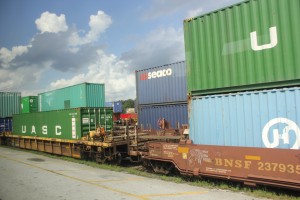 The terminal includes two Class I railroads on-site that provides freight by train to boat without weight restrictions. Other ports without a rail system have weight restrictions when moving containers via truck. The rail system helps with moving 2,000 lbs. a thousand miles on a single gallon of fuel. The port also sees approximately 8,000 trucks in and out through the day.
The terminal includes two Class I railroads on-site that provides freight by train to boat without weight restrictions. Other ports without a rail system have weight restrictions when moving containers via truck. The rail system helps with moving 2,000 lbs. a thousand miles on a single gallon of fuel. The port also sees approximately 8,000 trucks in and out through the day.
The port has also invested in more than 2,800 refrigerated container spaces, with more on the way. The refrigerated space allows another known Georgia product, poultry, to be exported through Savannah. In fact, the Port of Savannah exports so much poultry that if Georgia was a country then the state would be the fourth largest poultry exporter in the world.
Here’s a quick video clip of cargo being unloaded from a container ship at the Port of Savannah.
A growing opportunity in the export market
 During lunch at the Bulloch County Extension office, tour attendees were able to learn more about the peanut export market from Stephanie Grunenfelder, vice president of international marketing with the American Peanut Council. According to Grunenfelder, inshell exports in 2013 were 82,000 MT, almost double those in 2012. She says the biggest export increases were to Europe. For the first half of 2014, exports have continued strong for the U.S., she says. While lower than last year, they are still way ahead of the five year average many traders say that will total almost as high as last year.
During lunch at the Bulloch County Extension office, tour attendees were able to learn more about the peanut export market from Stephanie Grunenfelder, vice president of international marketing with the American Peanut Council. According to Grunenfelder, inshell exports in 2013 were 82,000 MT, almost double those in 2012. She says the biggest export increases were to Europe. For the first half of 2014, exports have continued strong for the U.S., she says. While lower than last year, they are still way ahead of the five year average many traders say that will total almost as high as last year.
One of the U.S. key export markets is Japan. “Currently, the Japanese buy the majority of their peanuts from China, but we are trying to change that,” Grunenfelder says. “Japan prefers Virginia type peanuts. We are working very hard to get the duty on U.S. peanuts going into Japan dropped to zero under the Trans Pacific Partnership trade agreement currently being negotiated. If we are successful, we think we will suddenly start selling a lot more Virginia type peanuts to Japan which could be a real boost to the V-C peanut region.”
Currently the top five export markets for U.S. peanuts are the European Union, Canada, China, Mexico and Japan. Peanuts are exported in a variety of ways with the top export type being kernels followed by inshells, blanched, peanut butter and lastly prepared. When reviewing the last few years, Grunenfelder says, the export market has grown in the following areas:
Inshell
$35.5 million in 2008
$82.3 million in 2013
Shelled
$197.8 million in 2008
$415 million in 2013
Peanut Butter
$53.3 million in 2008
$152.9 million in 2013
According to reports so far in 2014, Grunenfelder says, the top markets for U.S. peanuts from January to June are the European Union, Canada, Mexico and Japan. Those countries total 88 percent of the total export market. So, what is happening with overall production and the export market? In addition to the American Peanut Council’s marketing efforts in other countries the forces of the world market have generated many changes in the peanut trade. Most countries produce and consume peanuts within their own country and only about 5 percent of the world’s volume is traded, unlike most commodities. China currently dominates world peanut production. However, China, Argentina, the U.S. and India compete for export markets around the world. In recent years, China’s economy has grown, and consumers there are eating more snacks and high value foods. Therefore, China consumes more of its own production and because of their size, drawing back exports affects everyone else, Grunenfelder says. The U.S. is best positioned to take up the slack, and has done so in many countries, including Africa. Pair this with growing middle class consumers in Africa, who are already familiar with peanuts as a snack, and you see why there are opportunities for exports, Grunenfelder adds.
The American Peanut Council manages an export promotion program on behalf of the industry, and utilizes funds from the United States Department of Agriculture’s Market Access Promotion Program, as well as the Foreign Market Development Program. These funds are used primarily to focus on the trade, and are targeted to key markets. To learn more, visit the USDA’s Foreign Agriculture website at: http://www.fas.usda.gov/.
Cromley brothers try hand at high oleic peanuts
Georgia Peanut Tour attendees visited the farm of Lee and Charlie Cromley in Brooklet, Georgia. Brooklet is a small town but it is known for the town’s annual peanut festival held in August. The event draws thousands of tourists each year to the small town. Visit the Brooklet Peanut Festival website to learn more about the event.
The Cromley’s farm just outside of town and grow 2,200 acres of cotton and 400 acres of peanuts. In the 300 acre field the tour group visited, the Cromley’s had planted the Georgia 06G and Georgia 09B varieties. The peanuts were planted the first week of May. The field has been very dry in August but over the last 10 days they have had 8-inches of rain which is preventing them from being able to get in the field and dig the peanuts. They are very innovative and on the cutting edge and they are looking for things to do better to improve yield.
The Georgia 09B is a high oleic variety where farmers are paid premiums to plant from several candy manufacturers that want more high oleic peanuts grown. However, less than 10 percent of the peanuts grown in Georgia are high oleic. One of the advantages of high oleic peanuts is the longer shelf life.
Lee Cromley says, is seems like more farmers should be growing a high oleic variety since it has several advantages. However, he says they have struggled with yield on the high oleic peanuts. “We planted another high oleic variety, Georgia 02C, a few years ago and that is a tough variety to manage from growth and maturity standpoint.” Cromley says. “Now, we have more varieties that are easier to manage and the yield is getting better. Even though yield drag is still 400 to 500 lbs. behind other non-high oleic peanuts. However, with the premium paid we feel like we will be fine with the reduced yield.”
Several companies like Hershey’s would like high oleic peanuts. However, it all comes down to the economics for growers.
“The market place is not built yet to accept high oleic and a grower wants to grow what yields and pays him back,” says Scott Monfort, University of Georgia peanut agronomist. “If everyone adopts high oleic peanuts right now then there would not be a premium offered and the premium is offered to offset the yield loss of those varieties. Without the premium that would negate the reason to grow high oleic peanut varieties today with reduced yield. We need to work on producing high oleic varieties that have the yield potential of Georgia 06G.”
Sikes conducts on-farm research to control thrips
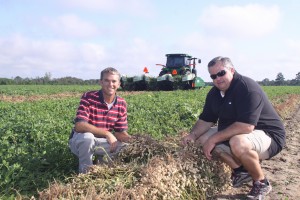
Pictured left to right: Bill Tyson, Bulloch County Extension agent, and Greg Sikes, farmer from Brooklet, Georgia.
The first field visit on the Georgia Peanut Tour is the farm of Greg Sikes in Bulloch County, Georgia. Sikes has been farming 16 years and grows 7,000 acres of cotton, peanuts, corn and soybeans. His grandfather and uncle farmed but Sikes has not farmed any of that land until two years ago. Sikes is a very innovative farmer, says Bill Tyson, Bulloch County Extension agent.
In 2014, Sikes planted Georgia 06G in a twin and single rows. The research tests use Thimet in-furrow on single rows and Imidacloprid in-furrow on twin rows to help with control of thrips. According to Sikes, planting in twin rows uses more expensive equipment but the twin rows help with controlling thrips and weeds. The peanuts were planted April 28 and the conditions at that time were pretty good. The peanuts have had a pretty good growing season as you can tell by the vines, Sikes says, except for a few weeks ago when the heat index reached 100 to 105 degrees every day.
According to Tyson, Sikes peanuts are ready to dig and normally he would be in the field digging but over the past week he has had about 8 inches of rain in this area. So, now we are looking for some sunshine. Tyson says, the tour should have come through this area about five weeks ago when farmers really needed rain and brought rain to us then. The peanuts are ready to be dug but we have to deal with what Mother Nature has given us.
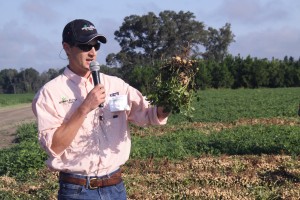 Mark Abney, peanut entomologist at University of Georgia also visited with attendees during the tour about insect pressure especially Thrips. Thrips are a tiny little insect that affects peanuts and causes tomato spotted wilt virus. The TSWV would have devastated the peanut crop across the Southeast but many plant breeders developed TSVW resistant varieties. Thrips is the only way TSWV is spread. Thrips also suck on plant juices and stunt the plant the first four weeks of the plants life at the beginning of the season. For many years, farmers used Timek to control peanuts but EPA banned the product a few years ago. So, now the industry is forced to figure out a new way to control thrips. Our goal is to help the grower and increase efficiency by making one trip through the field by applying insecticide at planting. We are not 100% in finding a solution but we are working towards that to help farmers.
Mark Abney, peanut entomologist at University of Georgia also visited with attendees during the tour about insect pressure especially Thrips. Thrips are a tiny little insect that affects peanuts and causes tomato spotted wilt virus. The TSWV would have devastated the peanut crop across the Southeast but many plant breeders developed TSVW resistant varieties. Thrips is the only way TSWV is spread. Thrips also suck on plant juices and stunt the plant the first four weeks of the plants life at the beginning of the season. For many years, farmers used Timek to control peanuts but EPA banned the product a few years ago. So, now the industry is forced to figure out a new way to control thrips. Our goal is to help the grower and increase efficiency by making one trip through the field by applying insecticide at planting. We are not 100% in finding a solution but we are working towards that to help farmers.

